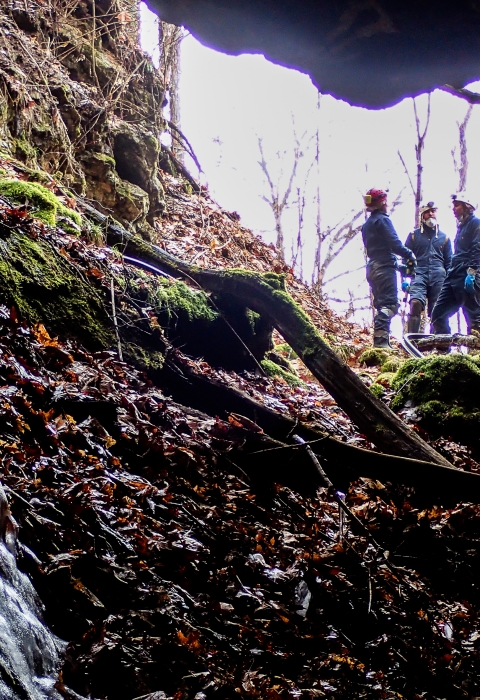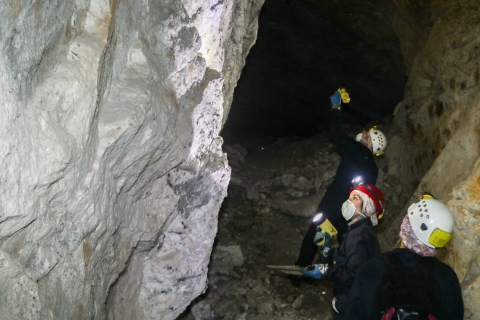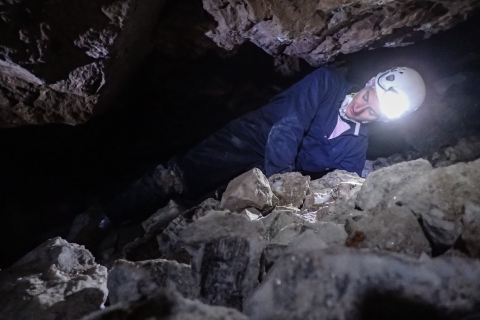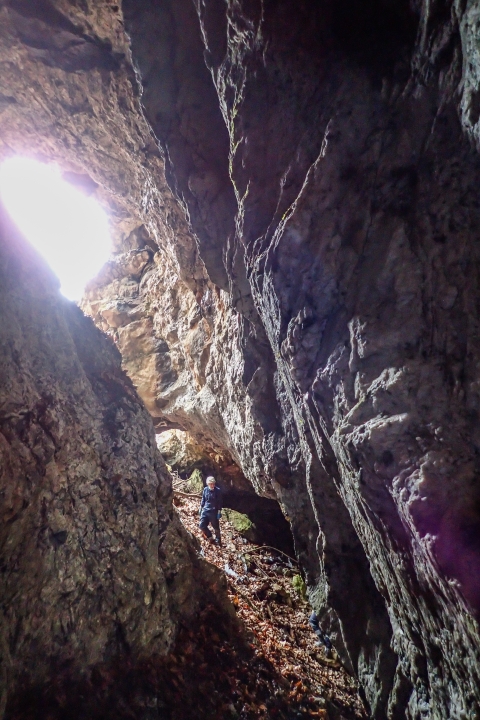Asheville, North Carolina — A short way into an abandoned mica mine in western North Carolina’s Haywood County, U.S. Fish and Wildlife Service biologist Susan Cameron pointed to the chamber’s high ceiling, explaining that it’s where the majority of the mine’s hibernating bats used to find shelter.
The mine sits on protected land, not far from the Blue Ridge Parkway. It’s accessed by a long, rough dirt road that sits behind a locked gate. It’s a corner of the Blue Ridge Mountains rarely trampled by humans.
“The bats exist essentially free of human disturbance — even the wildlife biologists who keep tabs on them don’t visit the site every year,” said Cameron. “It should be a place where bats flourish… but they don’t.”
The team of state and federal wildlife biologists visited the mine in January, the latest installment in a multi-year effort to track bat numbers in the mine. Biologists continued beyond the expansive chamber near the entrance — down one path, then down a deeper tunnel, as the ceiling got lower and lower, first requiring them to hunch over, then squat, then go on all fours, before having to squeeze into the mine’s deepest and final chamber on their stomachs. Occasionally a bat was found clinging to the ceiling just above the path, leading biologists to pass the word back to ensure the next person coming through didn’t wake it, causing it to use precious winter fat reserves needed to get through hibernation.
Hours later, the group emerged onto the surface. After everyone took turns guessing how many bats were found that day, the data keeper announced the tally: 66. In a way, it was good news. It was higher than the last couple of times biologists had inventoried the cave. However, it was far short of the more than 3,500 bats found when the mine was the most populous bat hibernation site in North Carolina — before white-nose syndrome swept through.
Years before COVID-19 altered the daily life of people around the world, white-nose syndrome upended bat populations in eastern North American and overhauled the way wildlife biologists approach working with bats. White-nose syndrome is a fungal disease. It was first discovered in a New York cave in 2006 and has since spread in all directions, arriving in North Carolina in 2011. In 2012, the Service estimated at least 5.7 to 6.7 million bat deaths due to white-nose syndrome. Since then, it is has spread into Great Plains states, the northern Great Lakes area, and even popped up as far west as Washington state.
Since the discovery of the disease in North Carolina, biologists have tracked the decline of the state’s bat populations and are able to describe it in very real numbers. The abandoned mica mine is one of the most egregious examples, but it is not alone. A former iron mine in Avery County went from more than 1,800 bats in 2008 to a low of 11 in 2016. A Swain County cave went from more than 1,300 in 2010 to 21 in 2018. An abandoned iron mine in Yancey County went from 565 bats in 2005 down to three in 2014.
Wildlife biologists responded to white-nose syndrome by implementing new protocols to check the disease’s spread. Gone were the days of simply donning leather hiking boots and blue jeans to enter caves and mines. Today, biologists wear multiple layers of clothing, duct-taping the seams so the fungal spores remain on the outside. Upon exiting a cave, every piece of equipment is wiped or dipped with a Lysol or bleach solution. Clothes are carefully removed and sealed in plastic bags to be washed in hot water with disinfectant.
In 2015, northern long-eared bat became the first bat placed on the federal threatened and endangered species list due to white-nose syndrome. It was last seen in the mica mine in 2014. The mine was once the most important North Carolina site for tri-colored bats, which is currently under consideration for Endangered Species Act protection. This year, 45 were found in the mine, though more than 3,000 were found there 10 years ago.
The decline in bat numbers has a very practical side. Every single species of bat found in North Carolina is an insect eater, consuming large numbers of forest, crop, and human pests. Some research suggests that bats could save farmers more than $3 billion in pest control every year.
Despite the dramatic declines since 2012, recent numbers indicate bat populations may have bottomed out and at some sites very slight increases have been seen.
“Overall, results from winter bat surveys were more encouraging than they have been since the grim effects of white-nose syndrome began in North Carolina,” said Katherine Etchison, biologist with the North Carolina Wildlife Resources Commission. “Hopefully these increases in the numbers of hibernating bats continue and become widespread, but that’s a best-case scenario and still a question mark. Even if this is the case, it would take a long, long time for bat populations to rebound.”







